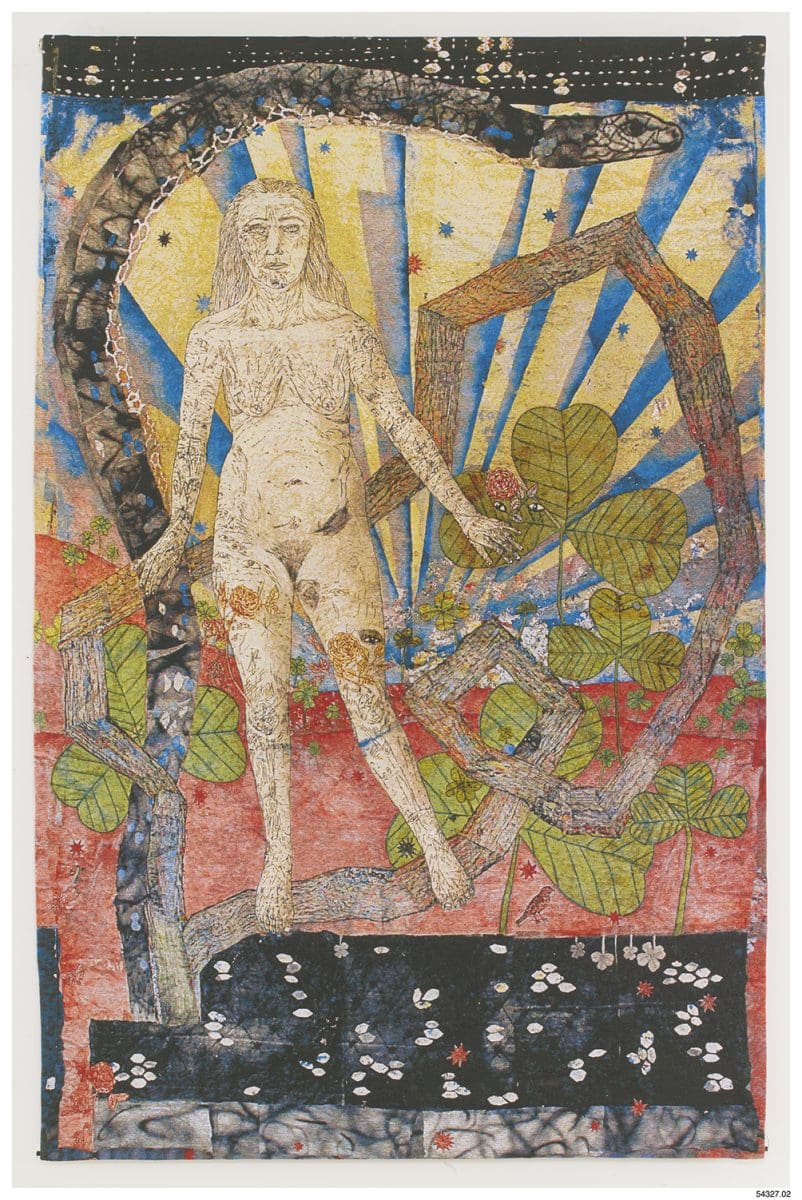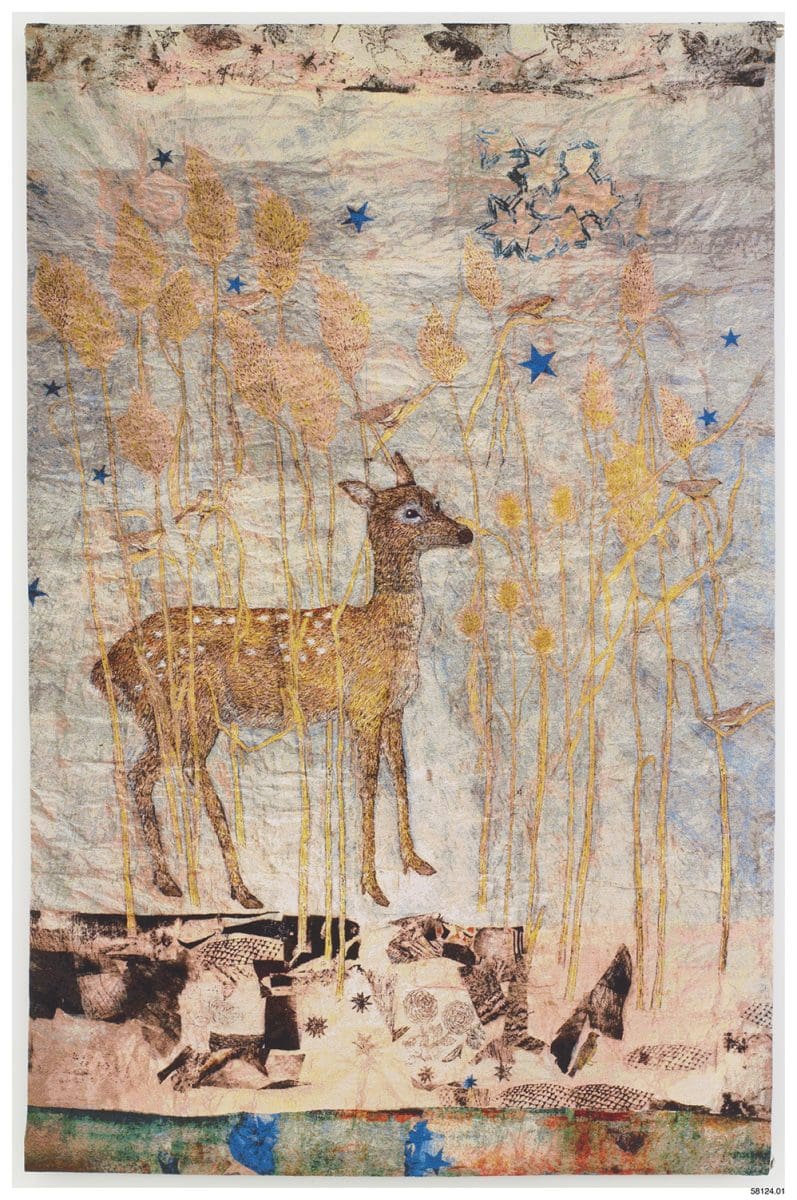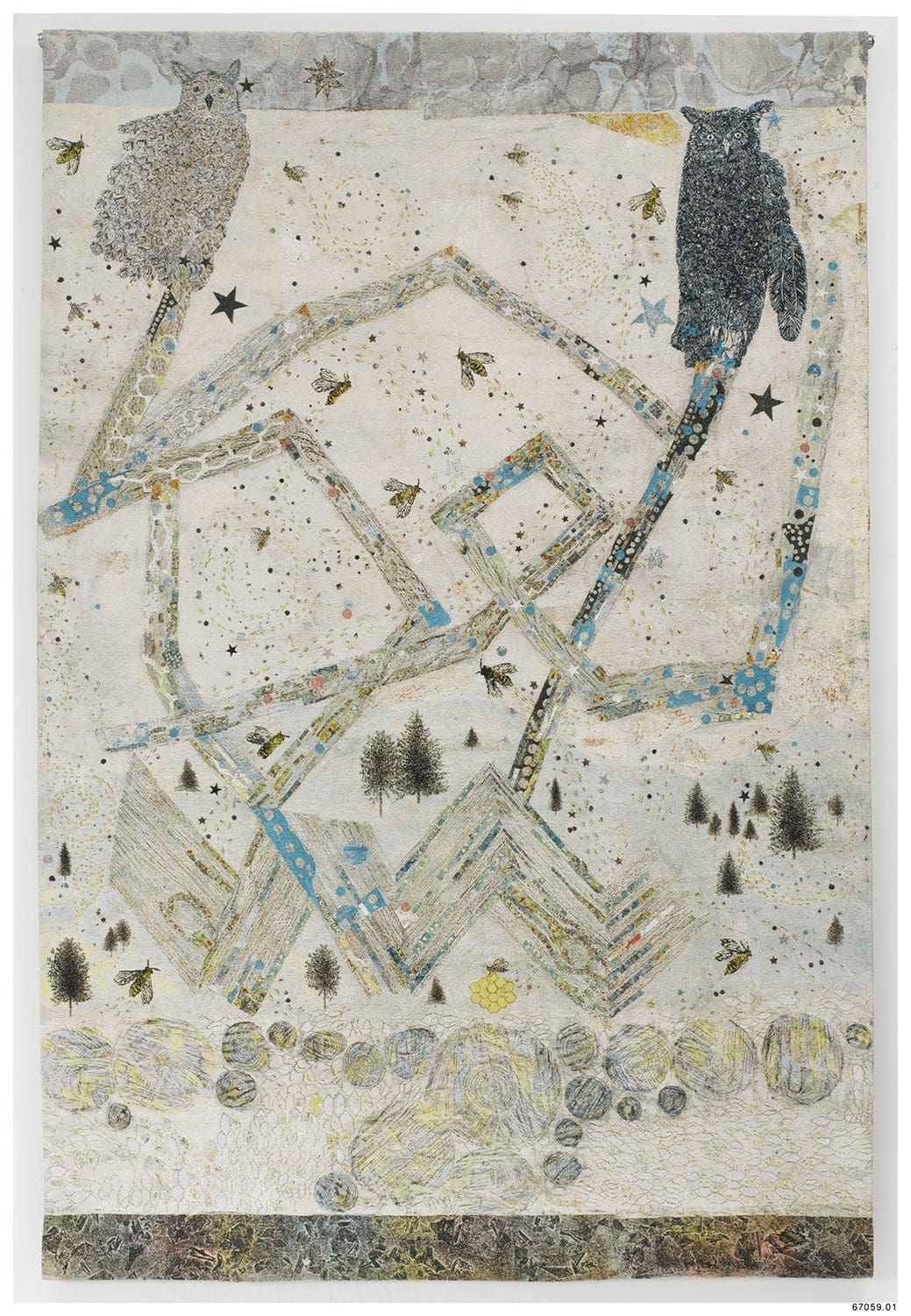
Making Space at the Table
NAP Contemporary’s group show, The Elephant Table, platforms six artists and voices—creating chaos, connection and conversation.




Since the 1980s acclaimed American artist Kiki Smith has been creating multidisciplinary works on mortality, sexuality, nature and embodiment. From sculptures of the body, to drawings based on mythology and fairy tales, to incredible tapestries—which are showing for the Biennale of Sydney—Smith has pushed at the boundaries of form, creating works that are beguiling in their existence. Her work has shown in five Venice Biennales, and in 2006 she was recognised by TIME Magazine as one of the ‘TIME 100: The People Who Shape Our World.’ Here, Smith talks about the process of making art and being patient in the face of the uncontrollable.
Tiarney Miekus: For someone whose work looks at cycles of decay and renewal, has making art felt different to you recently, with a pandemic and growing environmental degradation?
Kiki Smith: No, I just think it teaches one patience and being quiet, and really understanding that you can’t go through life ‘willing’ the next thing you do. It’s about acceptance of things—of time and limitations. And maybe about prudence—being more prudent and thinking in a more modest manner, and realising you’re not that in control of things, and seeing that as a great gift.
TM: Is creating a sense of filtering or understanding those larger uncontrollable things?
KS: I think it’s a lot about making a proof. It’s like a proof of yourself, or a reflection—something to reflect back on yourself. It takes a certain amount of energy to manifest things out of nothing, and it’s certainly not out of any necessity other than your own necessity. Artists are extremely driven people, much to the chagrin sometimes of their families and everyone else around them. We’re like a train going through a house. You’re manifesting things that have reference to the whole history of what has existed, and what you’ve learnt from what everyone else has done in the world, and then you have your own slice that makes you preoccupied by something, and very curious and tenacious about manifesting it physically. Part of it is maybe psychological, and then the other part is like a divine gift I’ve been given. But I need to work every day—a lot. It’s not like I can just be blind in the dark, drawing and it comes out perfect. I make endless revisions and mistakes and corrections.
TM: I first encountered your work through your earlier sculptures, particularly of the female body and your bodies of great frailty, vulnerability and abjectness. These works have been aligned with post-feminism and the Aids crisis throughout the 80s and 90s, but I wonder if you reflect differently on them now?
KS: I think they fit with the times when I made them, but then they fit with my age when I made them. I’m 67 now, and it was in my thirties that I made most of that work. That’s a time when you’re grappling between your childhood and trying to become an adult—even though I’m slowly, slowly, slowly still doing that. But I was a very conflicted person about everything and in a lot of discomfort with being in the world, and those works fitted to social things that were happening— but really, it came out of my personal discomfort. I don’t think that my personal discomfort is unique, and certainly in terms of being a woman there’s a great deal to have discomfort about: the pressures that are put on women that don’t belong to them inherently. There are times in your life where you’re trying to figure out how to shave off the parts of your inheritance—your cultural, personal inheritance— that doesn’t fit you. And you experience it personally, but then everybody’s experiencing their own personal version of that, in all different ways.
I feel lucky to have grown up when I did, and to become an artist when I did. I feel like it’s part of the first generation of women artists that really got to do their work: not unhindered, but much closer to not being hindered. I think women are still hindered in all aspects of life, but it was really a moment where things were changing. But for me it wasn’t intentional. It was completely out of discomfort.

TM: Discomfort is an interesting word because you grew up Catholic, which seems to me a very body-centered religion, and you also worked as a medical assistant, and your father and sister both had different illnesses—they’re things all related to the body, and all quite painful. And something about those earlier works does seem painful to me. Is that something you would identify with?
KS: I certainly did [laughs]. But at the same time, I always had firstly a humour about things, and second, a tenacity. I have a lot of force in me—hopefully not too much in a bad way, but I didn’t want to be stopped. I needed to make my expression and I remember being criticised by friends of how I made things, people saying they were too tentative or precarious. And then I thought, “Fine, I’ll just make it worse. I’ll make it worse and worse and worse.” I’m also a lousy crafts person. I really love craft and decorative arts, and, as I get older, it becomes more apparent how my real focus in life is something about decorative arts, about the nuances of how people configure things. Like printmaking is something that is completely enthralling to me and exists at every aspect of my life. I think for most artists they’re very driven by nuanced, formal concerns.
TM: That makes me think of your father, Tony Smith. He was a renowned minimalist sculptor and there’s a narrative given to your work that your figurative sculpture was a rejection of his more modernist, masculine approach. And you’ve very politely rejected that stance in interviews I’ve read.
KS: My father’s work was very ‘body oriented’ in the sense of scale. The scale was always in relationship to the body. And he was an architect, so he was used to thinking about people in space, in occupying space. Then some of his work was figurative in a certain way, but it was also based in natural phenomena— octahedrons and tetrahedrons. My sister Seton Smith is an artist too, and she makes photographs of nature or architecture, and we’re all very engaged in whatever we were doing, but it all could exist simultaneously.
TM: When you were making your early figurative work, especially in the late 80s and early 90s, it seems like the art world was so centered on performance and identity-driven art.
KS: Identity-driven art happened after I stopped making the [early] figurative pieces, which was the mid-90s. But figuration wasn’t really popular then [in the late 80s]. When I started making figurative things it wasn’t on purpose. Somebody gave me a copy of Gray’s Anatomy, which is that famous anatomy book from the 1800s, and it resonated for me. It really resonated. I could just look at the liver system or the mouth, everything was so exciting. The person who also really liked anatomy was Jean-Michel Basquiat, and at the same time [as me]. But he became known for his work 10 years before I did, and he was younger than me, but he really liked anatomy. He was looking at Gray’s Anatomy and working very directly from it also—but figuration wasn’t popular.
When I came to New York, after a couple of years I fell into a group of artists called Collaborative Projects Inc. and they had all gone to this thing called the Whitney Program. Most of them had been very influenced by thinking about art in relationship to social movement—making films, magazines and bands. Generally, they weren’t making abstract work. They were making some kind of representational work, but not necessarily figurative. People started focusing on the possibilities of representational work and making art that was accessible. It wasn’t art that someone had to know a lot about to have an experience.
TM: Something I love in your work is the recognisable imagery from mythology, fairy tales and folklore. Where does that stem from?
KS: My mother used to read us fairytales and my father read us Edgar Allan Poe, which of course is much scarier, but even the fairy tales are scary. Like I love The Tinderbox, which is a story of a witch being locked underground by a soldier returning from war. I guess I identify with that witch being locked in a box, because that is something that comes often to my mind. There are also biblical children’s stories that still resonate for me. Then later I saw Joan Jonas made work based on fairy tales. She is a brilliant artist and a big influence on me in no particularly apparent way. But in the mid-90s I stopped making figurative work: I visited Harvard’s Peabody Museum and the woman scientist I spoke to was making predictions about how many mammals would become extinct in the next 50 years—I stopped making figures and went back to focusing on animals.
It was also a moment when sexual identity politics was becoming more overt and a big part of the art world, and I didn’t know if I had anything to say about it. I wasn’t trying to work topically, but, I think at that time, what I learnt about the mammals, it was so sorrowful and mournful, and I collected newspaper articles about animals for a couple years and made poster boards from them. Then I just started making images of animals, and then I got into fairy tales because I thought it was an intersection in my cultural history where there was this active relationship between animals and humans.

TM: In the fairy tale-related works there are often depictions of women, and something I appreciate is how the representation changes—sometimes the women are very powerful, sometimes they’re being hunted. It’s not one-dimensional.
KS: We’re all complicated. I’m complicated. I have no agenda to try to make a freedom front—I just want to make what I’m given, and it can’t be everything. When I was younger there was an external push to make things that “fit together” and it wasn’t interesting to me. We’re all very contradictory in our being. I don’t want to make didactic work, or work that comes out of an agenda. You have to be like a lightning rod and catch as much static electricity, lightning coming through the atmosphere, and then ground it somehow in a form.
You know, I wish I could go back to Gray’s Anatomy and things like that, but I don’t know how to. It’s territory that I love, but it doesn’t tell me how to speak through it anymore. When I was younger, I was much stricter about how I had to draw a certain way or do things a certain way, and all of that disappeared over time.
TM: That falling away of self-imposed strictness to something looser seems like a passage many artists go through. Is it because you get more confident?
KS: No, you just forget what your idea was [laughs]. No, no—it’s that you have the history of trust, and the more you trust what you’re given, the freer you can walk in that space. I know for myself my work hasn’t ever harmed me. It’s always brought me closer.
TM: Closer to . . . ?
KS: To me and the world.
TM: For the Biennale of Sydney, you’re exhibiting five tapestries that look exquisite. I know you started tapestries around 10 years ago, but what prompted that shift?
KS: Tapestries are an incredible form. First, they blanket the world, they blanket walls. I went to Morocco when I was young and saw wall hangings that blanketed and protected and revealed the culture at the same time. And then the whole history of European tapestries is a completely insane history. It’s so fascinating. When I was about 30, I went to Angers to see the Apocalypse Tapestry [a large medieval series of tapestries], which were one of the best things I ever saw in my life. They still shock me every time I look at pictures of them.
But I never really thought that I would have the opportunity to work with the form. Because of modern technology and innovations with Jacquard loom weaving and computers, I was offered an opportunity by Magnolia Editions, which are in Oakland, California. It gave me the opportunity to use colour, which is something that I was very shy about. I always found colour very egocentric and so personal. It is so subjective that it made me nervous. I’ve been making black drawings on natural fiber paper for years.
So, it gave me colour and the opportunity to make something in the form. So far I’ve made 13 tapestries and working with tapestry and Magnolia Editions has been a great journey for me.
Kiki Smith
Museum of Contemporary Art Australia
12 March—13 June
This article was originally published in the March/April 2022 print edition of Art Guide Australia.